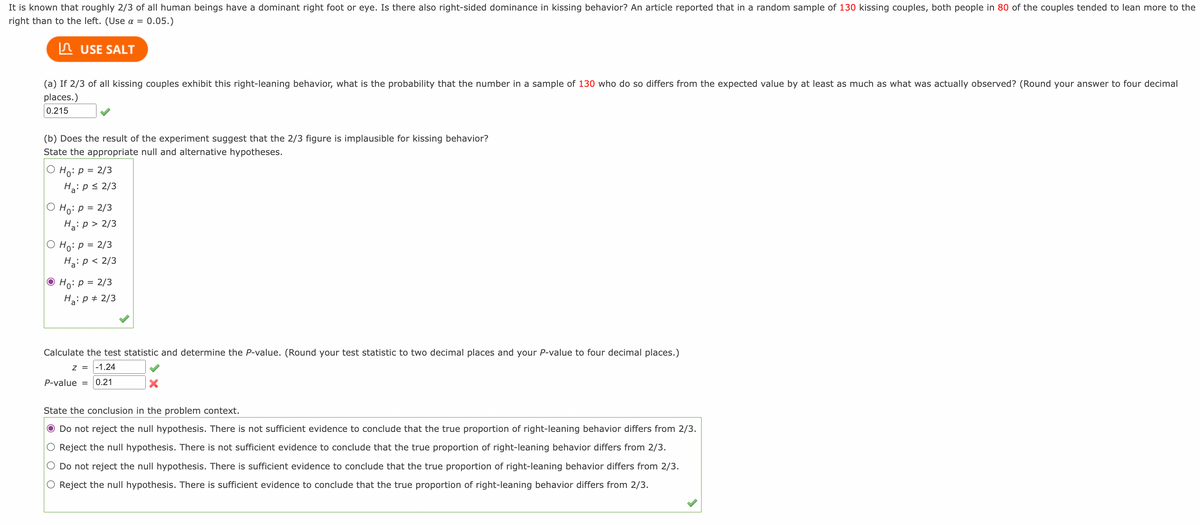It is known that roughly 2/3 of all human beings have a dominant right foot or eye. Is there also right-sided dominance in kissing behavior? An article reported that in a random sample of 130 kissing couples, both people in 80 of the couples tended to lean more to right than to the left. (Use a = 0.05.) USE SALT (a) If 2/3 of all kissing couples exhibit this right-leaning behavior, what is the probability that the number in a sample of 130 who do so differs from the expected value by at least as much as what was actually observed? (Round your answer to four decimal places.) 0.215 (b) Does the result of the experiment suggest that the 2/3 figure is implausible for kissing behavior? State the appropriate null and alternative hypotheses. O Ho: P = 2/3 H₂: Ps 2/3 O Ho: P = 2/3 H₂:p> 2/3 O Ho: P = 2/3 H₂: p < 2/3 ⒸHo: P = 2/3 H₂: P = 2/3 ✓ Calculate the test statistic and determine the P-value. (Round your test statistic to two decimal places and your P-value to four decimal places.) z = -1.24 ✓ X P-value = 0.21 State the conclusion in the problem context. Do not reject the null hypothesis. There is not sufficient evidence to conclude that the true proportion of right-leaning behavior differs from 2/3. O Reject the null hypothesis. There is not sufficient evidence to conclude that the true proportion of right-leaning behavior differs from 2/3. O Do not reject the null hypothesis. There is sufficient evidence conclude that the true proportion of right-leaning behavior differs from 2/3. O Reject the null hypothesis. There is sufficient evidence to conclude that the true proportion right-leaning behavior differs from 2/3.
It is known that roughly 2/3 of all human beings have a dominant right foot or eye. Is there also right-sided dominance in kissing behavior? An article reported that in a random sample of 130 kissing couples, both people in 80 of the couples tended to lean more to right than to the left. (Use a = 0.05.) USE SALT (a) If 2/3 of all kissing couples exhibit this right-leaning behavior, what is the probability that the number in a sample of 130 who do so differs from the expected value by at least as much as what was actually observed? (Round your answer to four decimal places.) 0.215 (b) Does the result of the experiment suggest that the 2/3 figure is implausible for kissing behavior? State the appropriate null and alternative hypotheses. O Ho: P = 2/3 H₂: Ps 2/3 O Ho: P = 2/3 H₂:p> 2/3 O Ho: P = 2/3 H₂: p < 2/3 ⒸHo: P = 2/3 H₂: P = 2/3 ✓ Calculate the test statistic and determine the P-value. (Round your test statistic to two decimal places and your P-value to four decimal places.) z = -1.24 ✓ X P-value = 0.21 State the conclusion in the problem context. Do not reject the null hypothesis. There is not sufficient evidence to conclude that the true proportion of right-leaning behavior differs from 2/3. O Reject the null hypothesis. There is not sufficient evidence to conclude that the true proportion of right-leaning behavior differs from 2/3. O Do not reject the null hypothesis. There is sufficient evidence conclude that the true proportion of right-leaning behavior differs from 2/3. O Reject the null hypothesis. There is sufficient evidence to conclude that the true proportion right-leaning behavior differs from 2/3.
Chapter8: Sequences, Series,and Probability
Section8.7: Probability
Problem 11ECP: A manufacturer has determined that a machine averages one faulty unit for every 500 it produces....
Related questions
Question
100%
I am having trouble with this homework question

Transcribed Image Text:It is known that roughly 2/3 of all human beings have a dominant right foot or eye. Is there also right-sided dominance in kissing behavior? An article reported that in a random sample of 130 kissing couples, both people in 80 of the couples tended to lean more to the
right than to the left. (Use a = 0.05.)
USE SALT
(a) If 2/3 of all kissing couples exhibit this right-leaning behavior, what is the probability that the number in a sample of 130 who do so differs from the expected value by at least as much as what was actually observed? (Round your answer to four decimal
places.)
0.215
(b) Does the result of the experiment suggest that the 2/3 figure is implausible for kissing behavior?
State the appropriate null and alternative hypotheses.
Ho: p = 2/3
Ha: p ≤ 2/3
Ho: P = 2/3
Ha: p > 2/3
O Ho: P = 2/3
Ha: p < 2/3
Ho: p = 2/3
Ha: p = 2/3
Calculate the test statistic and determine the P-value. (Round your test statistic to two decimal places and your P-value to four decimal places.)
Z = -1.24
P-value = 0.21
State the conclusion in the problem context.
Do not reject the null hypothesis. There is not sufficient evidence to conclude that the true proportion of right-leaning behavior differs from 2/3.
Reject the null hypothesis. There is not sufficient evidence to conclude that the true proportion of right-leaning behavior differs from 2/3.
Do not reject the null hypothesis. There is sufficient evidence to conclude that the true proportion of right-leaning behavior differs from 2/3.
O Reject the null hypothesis. There is sufficient evidence to conclude that the true proportion of right-leaning behavior differs from 2/3.
Expert Solution
This question has been solved!
Explore an expertly crafted, step-by-step solution for a thorough understanding of key concepts.
This is a popular solution!
Trending now
This is a popular solution!
Step by step
Solved in 2 steps

Recommended textbooks for you

